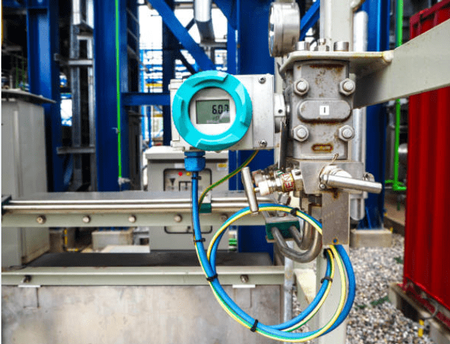Pressure transmitter is a kind of instrument which can convert pressure variable into standard output signal. There is a functional relationship between the pressure variable and the output signal of pressure transmitter.
According to different working principles and measuring methods, pressure transmitters can be classified into the following 11 types.
According to different methods of output signals, transmitters can be divided into current output type and voltage output type.
1. Pressure Transmitter of Voltage Output
Transmitter of voltage output can provide constant voltage.
Since the impedance of the voltage input terminal in the PLC analog input module of the transmitter is high, if the output signal of the pressure transmitter need to be sent for a long distance, the small interference signal current will produce a higher interference voltage in the input impedance of the module.
Therefore, if you use pressure transmitter of voltage output for remote transmission, its anti-interference ability of analog voltage signal is poor.
However, pressure transmitter of voltage output is suitable for sending the same signal to multiple instruments in parallel. For its installation is simple.
The disassembly of one instrument will not affect the work of other instruments, and the requirements for the output stage withstand voltage are reduced, so the reliability of the instrument is ensured.
The range of transmitter voltage signal is 1-5 V, 0-10 V, 1-10-10 V. The most common range are 1-5 V and 0-10V.
2. Pressure Transmitter of Current Output
Pressure transmitter of current output can provide constant current, which has a large internal resistance.
When the input signal of PLC analog input module in the transmitter is current, the input impedance will be low, and the interference voltage generated by the interference signal on the line on the module is even lower. Therefore analog current signal is suitable for remote transmission. When using shielded cable signal line, its signal transmission distance can be hundreds of meters.
The standard current signal for pressure transmitter of current output is 0 ~ 10 Ma, 0 ~ 20 mA, and 4 ~ 20 mA.
4-20 mA and 0 Ma are preferred more. They are usually used as alarm signals for circuit failure or power failure.
There are specific pros for both current signal transmission and voltage signal transmission.
Current signal is perfect for long distance transmission. Therefore for transmission signal in a control meter system, current signal is chosen as the signal form coming in and out of the control room.
On the other hand, voltage signal enables the instrument to be connected in parallel. Voltage signal can be used for the connection between the instruments in the control room.
That is to say, in a control meter system, current transmission is used as the way of connection and parallel receipt of voltage signal is used as the method to receive signal.
3. Pneumatic Pressure Transmitter
According to the different energy the transmitter uses, pressure transmitters can be classified into pneumatic transmitter and electric transmitter.
Pneumatic transmitter uses dry and clean compressed air as energy source, and it can convert various measured parameters, such as temperature, pressure, flow and liquid level into pressure signal of 0.02 ~ 0.1 IMPa. The output signal of the transmitter can be sent to a combined instrument of regulation and display unit for the purposes of alarm, recording or control.
Pros of Pneumatic Pressure transmitter
Simple and reliable structure of pneumatic transmitter
Strong anti-interference ability to electromagnetic field, radiation, temperature, humidity and other adverse environments.
Fire and explosion proof
Low cost
Cons of Pneumatic Pressure transmitter
Slow response speed
Limited transmission distance
Difficult to connect with computer
4. Electric Pressure Transmitter
Electric pressure transmitter is powered by electricity. It is able to transform all kinds of measured parameters into standard signal of DC current, 0 ~ 10mA or 4 ~ 20mA signal to other instrument of automatic control system.
In recent years, the electric transmitter are also used for explosion-proof instrument for safety consideration.
Pros of Electric Pressure transmitter
Convenient to connect for signals
Suitable for long-distance transmission
Easy to connect with computers
Cons of Electric Pressure transmitter
High costs
Temperature sensitive. It may be easily interfered by humidity, electromagnetic field and radiation.
5. Force Balance Transmitter
When you use a force balance transmitter to measure the pressure of a medium, the measured pressure is converted into a force through an elastic sensitive component in the transmitter, which deflects the balance lever. The deflection of the lever is converted from a detection amplifier to a 4-20mA DC current output.
The current signal flows through the feedback coil in the magnetic field to produce the electromagnetic feedback force which is balanced with the force. When the force and the feedback force reach dynamic balance, the lever system stops deflection. At this point, the current is the output current of the transmitter, which is proportional to the measured pressure.
6. Capacitive Transmitter
When you use a capacitive transmitter to measure the liquid pressure, the measured pressure will act on the measuring diaphragm to make the diaphragm displace, and the connecting shaft drives the electrode of the movable capacitance on it to produce a small displacement to make the capacitance change.
In the end, the capacitance transmitter will convert and amplify it into 4 ~ 20mA DC current signal through the circuit of conversion part.
7. Diffused Silicon Transmitter
When the pressure of the measured medium acts on the sealing diaphragm, the sealing diaphragm will push the filling liquid to transfer the pressure to the silicon cup. Because of the pressure, the diaphragm of the silicon cup will produce a elastic strain, which makes the resistance value of the four resistors diffused on the silicon cup to change.
With the change of the resistance value of the four resistors, the output of the bridge composed of the four resistors will change accordingly, which is proportional to the change of pressure.
8. Smart Pressure Transmitter
When the measured pressure acts on the sensor, its resistance will change accordingly. The resistance change is converted into electrical signal through bridge circuit, and then sent to microprocessor through analog-to-digital converter.
At the same time, the ambient temperature and static pressure are converted into electrical signals through the other two auxiliary sensors, and then sent to the microprocessor through the analog-to-digital converter.
After processing by the microprocessor, the ambient temperature and static pressure will be sent to the D/A converter, and the output is 4 ~ 20mA DC analog signal or 4 ~ 20mA DC digital signal.
9. Vibrating Wire Pressure Transmitter
When there is pressure to be measured, the tension of the vibrating string will change, so the vibration frequency will change accordingly. By measuring the change of vibration frequency, we can know the actual measured pressure.
Because the vibrating string is placed in a magnetic field, it will induce an electric potential when it vibrates. The frequency of induced potential is the frequency of vibration.
10. Optical Fiber Transmitter
The principle of the electro-optical conversion type optical fiber transmitter is to modulate the luminous intensity of the measured signals such as current through the electro-optical conversion elements such as a LED, and then transmit them in the optical fiber.
Optical fiber direct modulation type optical fiber transmitter works because under the action of force, some optical fibers are with the characteristics of refractive index, transmission loss or the length of optical fiber can easily change. With the mentioned changes and features, it’s able to detect the change of light intensity.
The combined type optical fiber transmitter is equipped with a photoelastic sensor in the optical path of the optical fiber, which changes the length of the optical path under the measured pressure. In this way, the transmitter can measure the pressure by the method of optical interference.
11. Optical Transmitter
When the measured medium pressure acts on the diaphragm of an optical transmitter, the pressure will be transmitted to the upper part of the sensitive element through the silicone oil, which results in the deformation of the flat diaphragm made as a mirror.
A sensitive optical fiber group is installed at the position corresponding to the diaphragm, and the deformation of the diaphragm changes the reflected light energy. The change of light energy is sent to the preprocessor through the optical cable, and then through the optical / electrical conversion, the transmitter can output a current signal of 4 ~ 20mA DC.
Thank you for your reading and more information please visit https://okmarts.com/news/







